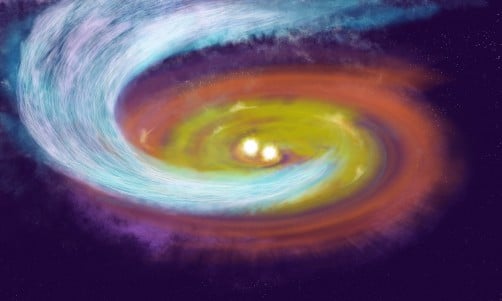
News
October 22, 2025
Astronomers Spot Magnetically-Guided Streamer Funneling Star-Building Material into Newborn System in Perseus
A team of astronomers led by Paulo Cortes, a scientist with the U.S. National Science Foundation National Radio Astronomy Observatory and the Joint ALMA Observatory, have made a groundbreaking discovery about how young star systems grow.
**Astronomers Uncover Cosmic Pipeline Feeding Infant Star System in Perseus**
A team of astronomers has peered into the heart of the Perseus molecular cloud and witnessed a cosmic phenomenon never before observed with such clarity: a magnetically-guided streamer of gas and dust actively funneling star-building material into a nascent star system. This groundbreaking discovery, led by Paulo Cortes, a scientist affiliated with the U.S. National Science Foundation's National Radio Astronomy Observatory and the Joint ALMA Observatory, sheds new light on the complex process of star formation and how young stars accumulate the mass they need to shine.
The Perseus molecular cloud, a vast stellar nursery located approximately 600 light-years from Earth, has long been a favorite target for astronomers studying the birth of stars. Within this cloud, stars are born from the gravitational collapse of dense pockets of gas and dust. However, precisely how these young systems gather enough material to ignite nuclear fusion and become fully-fledged stars has remained a subject of intense research.
The new observations, made possible by the Atacama Large Millimeter/submillimeter Array (ALMA) in Chile, reveal a distinct streamer of gas and dust stretching towards a very young star system still in its formative stages. What's particularly remarkable is the clear evidence that this streamer is being guided and shaped by powerful magnetic fields. These fields act like cosmic rails, channeling the material directly onto the growing star system, effectively creating a pipeline of star-forming ingredients.
Cortes and his team believe that these magnetic fields play a crucial role in overcoming the challenges faced by nascent stars. As a cloud of gas and dust collapses, it also begins to spin. This rotation can create a centrifugal barrier, preventing material from easily falling onto the central object. However, the magnetic fields effectively counteract this barrier, allowing the star system to continue accreting mass and grow.
This discovery provides compelling evidence for the importance of magnetic fields in the star formation process. By observing this actively feeding system in Perseus, astronomers gain invaluable insights into the mechanisms that govern the birth of stars and the evolution of planetary systems. The team's findings promise to reshape our understanding of the early stages of stellar evolution and pave the way for future research exploring the role of magnetic fields in similar star-forming regions throughout the galaxy.
A team of astronomers has peered into the heart of the Perseus molecular cloud and witnessed a cosmic phenomenon never before observed with such clarity: a magnetically-guided streamer of gas and dust actively funneling star-building material into a nascent star system. This groundbreaking discovery, led by Paulo Cortes, a scientist affiliated with the U.S. National Science Foundation's National Radio Astronomy Observatory and the Joint ALMA Observatory, sheds new light on the complex process of star formation and how young stars accumulate the mass they need to shine.
The Perseus molecular cloud, a vast stellar nursery located approximately 600 light-years from Earth, has long been a favorite target for astronomers studying the birth of stars. Within this cloud, stars are born from the gravitational collapse of dense pockets of gas and dust. However, precisely how these young systems gather enough material to ignite nuclear fusion and become fully-fledged stars has remained a subject of intense research.
The new observations, made possible by the Atacama Large Millimeter/submillimeter Array (ALMA) in Chile, reveal a distinct streamer of gas and dust stretching towards a very young star system still in its formative stages. What's particularly remarkable is the clear evidence that this streamer is being guided and shaped by powerful magnetic fields. These fields act like cosmic rails, channeling the material directly onto the growing star system, effectively creating a pipeline of star-forming ingredients.
Cortes and his team believe that these magnetic fields play a crucial role in overcoming the challenges faced by nascent stars. As a cloud of gas and dust collapses, it also begins to spin. This rotation can create a centrifugal barrier, preventing material from easily falling onto the central object. However, the magnetic fields effectively counteract this barrier, allowing the star system to continue accreting mass and grow.
This discovery provides compelling evidence for the importance of magnetic fields in the star formation process. By observing this actively feeding system in Perseus, astronomers gain invaluable insights into the mechanisms that govern the birth of stars and the evolution of planetary systems. The team's findings promise to reshape our understanding of the early stages of stellar evolution and pave the way for future research exploring the role of magnetic fields in similar star-forming regions throughout the galaxy.
Category:
Technology